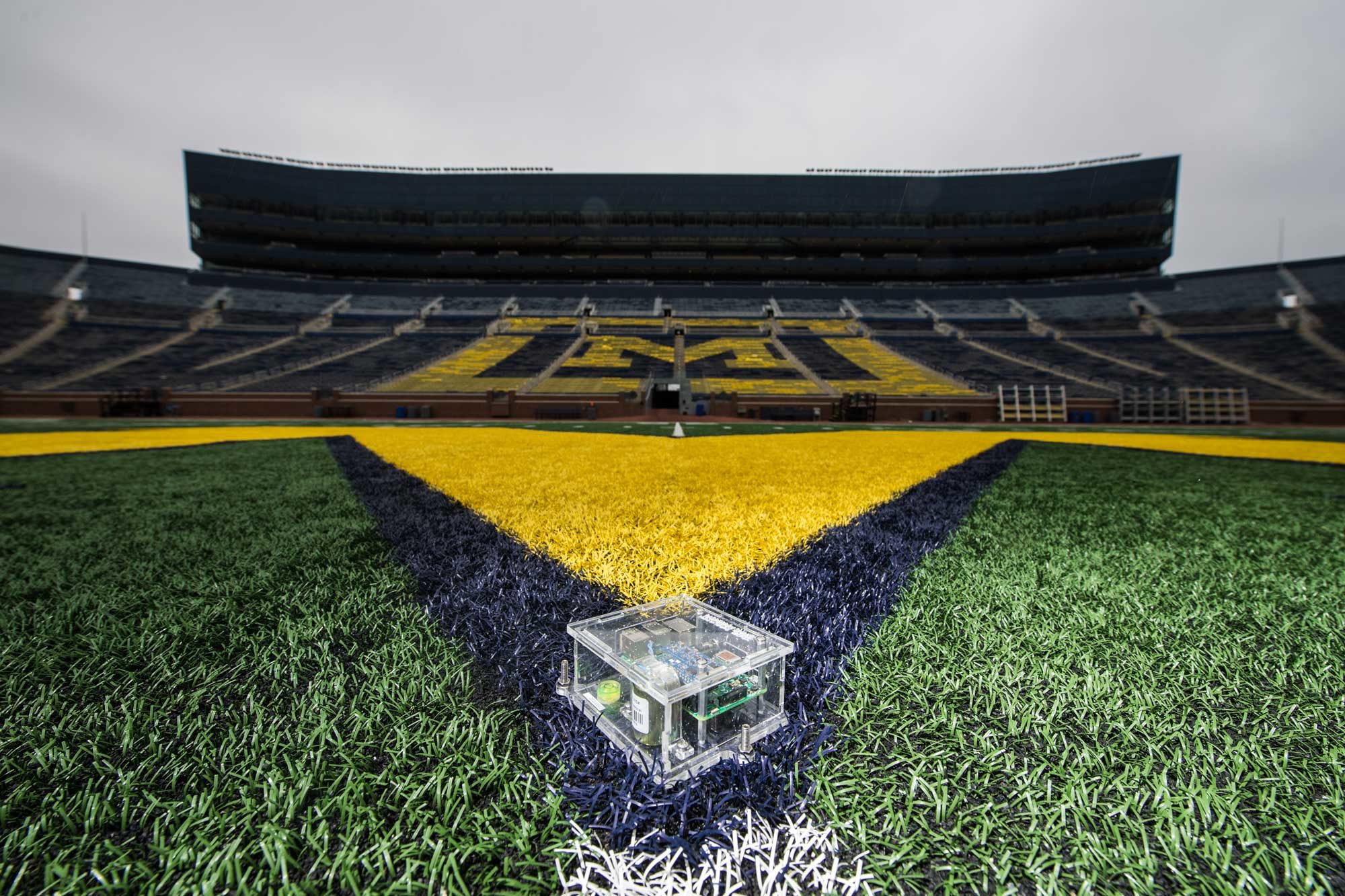ichigan Shake |
|
The surface of Earth is always shaking. Sometimes in response to natural events, close or far away, and more often from human activity. This shaking can be violent and damaging, such as that from large and nearby earthquakes, volcanic eruptions or nuclear explosions; other times, shaking is less violent, such as that from landfall of big storms or mining explosions. The many sources of Earth shaking produce characteristic patterns of vibrations that a seismometer records. Earthquakes, explosions, storms, building collapse, traffic all create different patterns. Michigan has only few natural shaking sources, but shows ample human activity. The Michigan Shake project tracks local shaking from audience response to game moments in the largest college football stadium in the nation: the Michigan Stadium. The raw data is real-time streaming above, showing shaking intensities as Counts and the local (Michigan) Time. We see that the locally sourced seismic signal is irregular and protracted, unlike sudden energy releases from an explosion or remote earthquake, or more steady city noise. The audience energy is small compared to natural earthquakes, perhaps less than Magnitude 1 on the seismic magnitude scale, but more than enough to shake the stadium and its occupants. Specific game events, like touchdowns (TDquakes) and band play, are easily recognizable, while shaking from the visiting team's TDs is, unsurprisingly, much less impressive. Because the seismometer is not calibrated for its specific location (surprisingly, test explosions in the stadium were not approved by facilities staff), we use the Michigan Magnitude (Mum), which is the 10log value of maximum shaking (maximum count); see explanation below. Whether Mum will become a global standard depends on the team's performances. |
|
Michigan News article: Good vibrations: Michigan Shake project measures crowd response during U-M home football games. Michigan Daily article: Geology professor measures seismic activity of Big House. Mlive article: These 5 moments made Michigan Stadium shake the most in 2018. See the U-M MichiganShake media clip here: large - small Follow posting on Twitter: #MichiganShake (posting by @vdpluijm) |
|
 |
A portable Raspberry Shake seismometer (R208E) is located in a top secret location inside the University of Michigan Football Stadium, at the corner of S Main and W Stadium in Ann Arbor, MI (map). A reference Raspberry Shake unit (R12C1) is located in a residential area, about 6km to the NW. The official USGS seismic station in the area is US.AAM, about 8.5km to the NE. Managed by Ben van der Pluijm, Professor of Geology, University of Michigan-Ann Arbor, USA. Comments welcome. |
Noisy location. Gates open for public at ~5:30p (21:30UTC) for first public team practice.
M7.8 earthquake, nearly 12,000km (7,500mi) away (after some noise filtering).
M7.5 earthquake, 14,800km away.
M7.0 earthquake, 4800km away. |
9/8/18, Western Michigan v Michigan 3-49 (TD=touchdown) TD 2; Mum=3.2 TD 3: Mum=3.1 TD 5: Mum=3.0 TD 6: Mum=2.8 When band engages (and synchronizes) audience: Mum=3.3 Decreasing MichiganMagnitude (Mum) as TDs accumulate in a one-sided game, while the band keeps audience lively. |
9/15/18, SMU v Michigan 20-45 The team enters, the crowd responds. Mum=3.2 Michigan's first TD. Mum=3.1 SMU counters; audience unimpressed. Mum=2.8 Michigan has taken control. Hicks pass intercepted, Metellus return for 73 yds TD. Mum=3.1 |
9/22/2018, Nebraska v Michigan 10-56 Surprisingly quick Michigan TD against stronger? opponent. Happy crowd: the biggest audience response this season so far. Mum=3.4 Second Michigan TD, soon after first. Mum=3.2 Third TD. Michigan clearly in control, and decreasing audience response. Mum=3.1 More points on the board. TDs getting easy. Snack time. Mum=3.0 On-site spotter: Sahil Tolia |
10/13/2018 Wisconsin v Michigan 13-38 K. Higdon rushing TD Mum=3.3 J. Metellus interception Mum=3.3 Singalong to "Mr. Brightside" Mum=3.6 L. Hill interception return for TD Mum=3.4 The rowdiest game so far (many swings over 2000). |
11/3/2018 Penn State vs UM: 7-42 S. Patterson rushing TD; Mum3.2 B. Watson interception return TD; Mum3.4. Crowd pleaser ! What happens at 6:21:30? Mum3.5 (BIG signal) K. Higdon rushing TD; Mum3.3 Another crushing win for Michigan Football. |
11/17/2018 Indiana vs Michigan 20-31 5:25 - Michigan - N. Eubanks receiving TD; Mum3.1 6:17 - Michigan - K. Higdon rushing TD; Mum3.1, and 6:24 - Michigan recovers fumble by Indiana's S. Scott; Mum3.0 |
11/17/2018 Indiana vs Michigan 20-31 6:35 Indiana QB sack; Mum3.2 6:51 Yes, audience does stomp-stomp-clap, stomp-stomp-clap (Queen's We Will Rock You); Mum 3.4 (biggest signal of the game) Lower-key audience on a cold game day (except WWRY song), with Michigan trailing and kicking for a modest win. |
See real-time seismic record at top of page
Live Web: https://raspberryshake.net/stationview/#?net=AM&sta=R208E
Recent Helicorder Displays: http://35.0.115.239/heli/
Ml = log (A/T) (+ F(h,Δ) + C)

Ml = local wave magnitude, with A is amplitude of signal (green), T (or λ) is dominant wavelength (red); typically using signal of first 5 seconds. F is a correction due to earthquake depth, (h) is distance from station (Δ in degrees), C is regional scale factor; here, F and C are zero.
Mum = Michigan Magnitude
Mum = log(count); count is event peak amplitude; wavelength is same for each event, so unused here.
Md = 1.86 x log (t) - 0.85
Md is duration magnitude, with t duration of shaking. (approx: Ml = 0.94 x Md - 0.16)
AM.R12C1 (Ann Arbor residential home):
https://raspberryshake.net/stationview/#?net=AM&sta=R12C1
US.AAM (Ann Arbor station):
https://www.iris.edu/app/station_monitor/#Today/US-AAM/webicorder/
https://earthquake.usgs.gov/static/earthquake-network-operations/Seismic_Data/telemetry_data/AAM.png
USGS: Latest Significant Earthquakes
IRIS: http://ds.iris.edu/wilber3/find_event
GFZ: https://geofon.gfz-potsdam.de/eqinfo/seismon/globmon.php
EMSC-CSEM: https://www.emsc-csem.org/Earthquake/significant_earthquakes.php
9-nov-22 12:02